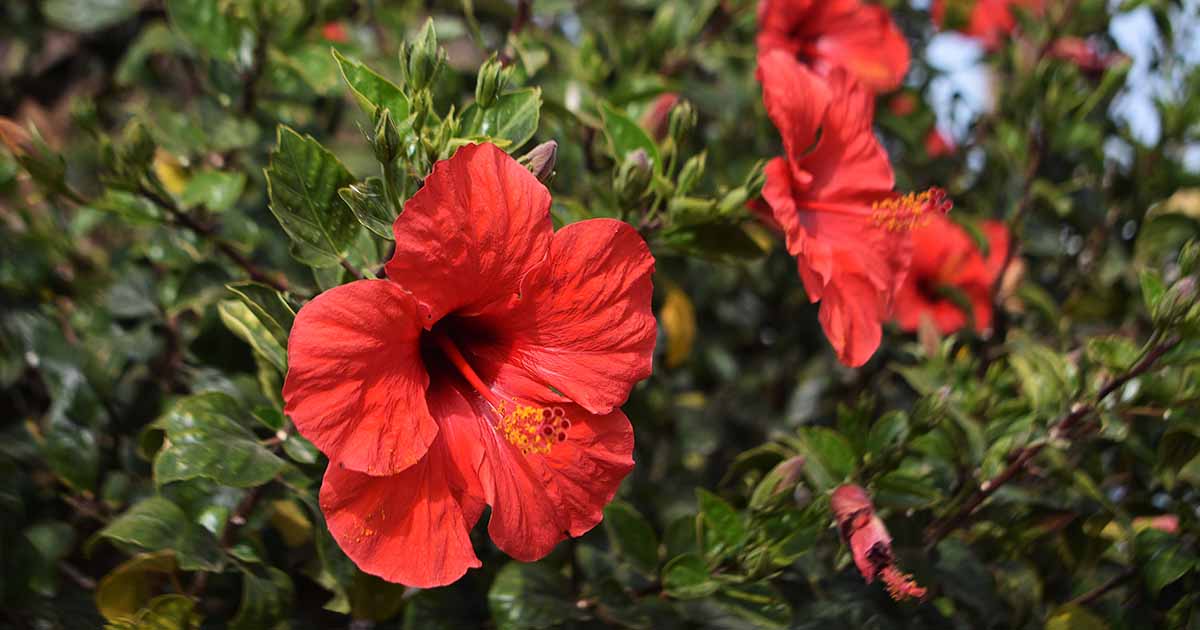
Hibiscus, with its vibrant and mesmerizing flowers, has captivated the hearts of people for centuries. This tropical and subtropical plant, belonging to the mallow family, is commonly found in various regions around the world. The allure of hibiscus goes beyond its visual appeal. In fact, it has been widely recognized for its medicinal properties and cultural significance. In this article, we will delve into the enigmatic world of hibiscus and uncover 16 fascinating facts about this remarkable plant. From its diverse species and stunning color variations to its historical uses and surprising health benefits, get ready to embark on a journey to unravel the mysteries of hibiscus. So, sit back, relax, and prepare to be enchanted by the captivating world of hibiscus!
Key Takeaways:
- Hibiscus flowers are not only beautiful but also have medicinal properties, making them a valuable addition to gardens and diets. They are easy to grow and attract butterflies and hummingbirds, adding color and life to any garden.
- The vibrant hibiscus flower is more than just a pretty face – it’s a versatile plant with cultural significance, culinary uses, and health benefits. From natural dyes to herbal teas, hibiscus adds a touch of exotic charm to various aspects of life.
The Hibiscus flower comes in a variety of vibrant colors.
Hibiscus flowers are known for their stunning array of colors, including red, pink, yellow, orange, and white. These vibrant hues make them a favorite choice for gardens and floral arrangements.
Hibiscus is not just a pretty flower – it has medicinal properties too!
Hibiscus is not only aesthetically pleasing, but it also offers numerous health benefits. Its leaves and flowers are used to make herbal teas that are believed to lower blood pressure, boost the immune system, and aid in weight loss.
Hibiscus is a tropical plant that thrives in warm climates.
This beautiful flowering plant is native to tropical regions and requires a warm climate to flourish. It loves sunlight and can be found in abundance in countries such as Malaysia, Hawaii, and India.
Hibiscus is the national flower of Malaysia.
In Malaysia, the hibiscus flower holds a special place as it is the national flower of the country. It is known locally as the “Bunga Raya” and symbolizes unity, pride, and courage.
Hibiscus flowers are edible and can be used in culinary creations.
Not only are hibiscus flowers visually appealing, but they are also edible! They can be used to add a touch of color and flavor to salads, desserts, and even beverages, giving them a unique and exotic twist.
The hibiscus flower has cultural significance in many countries.
The hibiscus flower is deeply rooted in culture and heritage. It is used in religious ceremonies, traditional dances, and even as a symbol of love and beauty in various cultures around the world.
Hibiscus tea is a popular beverage with numerous health benefits.
Hibiscus tea, made from the dried petals of the flower, is enjoyed by many for its refreshing taste and health benefits. It is believed to contain antioxidants, promote liver health, and aid in digestion.
Hibiscus flowers have been used for centuries in traditional medicine.
Throughout history, hibiscus flowers have been utilized in traditional medicine for their healing properties. They have been used to treat ailments such as high blood pressure, heart disease, and inflammation.
The hibiscus plant is easy to grow and maintain.
Whether you have a green thumb or not, the hibiscus plant is relatively easy to grow and care for. With proper watering, sunlight, and occasional pruning, you can enjoy the beauty of hibiscus in your own garden.
Hibiscus flowers are used for making natural dyes.
The vibrant pigments found in hibiscus flowers make them ideal for creating natural dyes. From clothing to artwork, hibiscus-based dyes have been used for centuries to add color and vibrancy.
Hibiscus flowers are a favorite nectar source for butterflies and hummingbirds.
The sweet nectar of hibiscus flowers serves as a magnet for butterflies and hummingbirds. If you want to attract these beautiful creatures to your garden, consider planting hibiscus.
Hibiscus is used in the cosmetic industry.
The beauty-enhancing properties of hibiscus have led to its inclusion in many cosmetic products such as shampoos, lotions, and face masks. It is believed to promote healthy hair and skin.
Hibiscus flowers bloom for only a day.
Despite their short lifespan, hibiscus flowers are a true spectacle when in bloom. Each flower typically lasts for only a day before withering, making their beauty even more special.
Hibiscus flowers are rich in vitamin C.
Hibiscus flowers are packed with vitamin C, which is essential for boosting the immune system and maintaining overall health. Including hibiscus in your diet can provide a natural source of this important nutrient.
Hibiscus plants can grow to be quite large.
Under optimal conditions, hibiscus plants can reach impressive sizes, with some varieties growing up to 15 feet tall. Their abundant foliage and beautiful flowers make them a statement piece in any garden.
Hibiscus flowers can be used to create natural hair dyes.
For those looking for a natural alternative to conventional hair dyes, hibiscus flowers can be used to create reddish or burgundy tints. This gives hair a unique and vibrant look while avoiding harsh chemicals.
Conclusion
In conclusion, hibiscus is a truly amazing and enigmatic plant that has captivated people for centuries. Its vibrant flowers, delicious tea, and impressive medicinal properties make it a must-have in any garden or herbal collection. Whether you’re a fan of its stunning appearance or its numerous health benefits, there’s no denying the allure of the hibiscus plant. From its origins in tropical regions to its widespread popularity around the world, hibiscus continues to fascinate and inspire. So next time you come across a hibiscus plant or enjoy a cup of hibiscus tea, remember these intriguing facts and appreciate the beauty and complexity of this remarkable plant.
FAQs
1. Are all hibiscus flowers edible?
Yes, most hibiscus flowers are edible, but it’s important to note that not all varieties taste the same. Some varieties, such as Hibiscus sabdariffa, are specifically grown for culinary use and are commonly used to make infusions and teas.
2. Can hibiscus tea help lower blood pressure?
Yes, hibiscus tea has been found to have a positive effect on blood pressure. Studies have shown that consuming hibiscus tea on a regular basis may help lower both systolic and diastolic blood pressure levels.
3. Can hibiscus plants survive in colder climates?
Hibiscus plants are typically found in tropical and subtropical regions, but some varieties can withstand colder temperatures. However, they may require additional care and protection during the winter months to ensure their survival.
4. How often should I water my hibiscus plant?
Hibiscus plants require regular watering, especially during hot and dry periods. It’s important to keep the soil consistently moist but not waterlogged. Watering once or twice a week should be sufficient, but the frequency may vary depending on the climate and soil conditions.
5. Can I grow hibiscus plants indoors?
Yes, hibiscus plants can be grown indoors, but they require ample sunlight and proper care. Place them near a sunny window and ensure they receive at least six hours of sunlight per day. Additionally, maintain appropriate humidity levels and provide adequate drainage to prevent root rot.
Hibiscus enthusiasts, your journey doesn't end here! Dive deeper into the world of this enchanting flower by exploring Chinese Hibiscus facts that will blow your mind. Quench your thirst for knowledge with unsweetened Hibiscus tea nutrition facts, and let Hawaii's state flower transport you to a tropical paradise. Each article offers a unique perspective on the captivating Hibiscus, promising to enrich your understanding and appreciation for this magnificent bloom. So, what are you waiting for? Click away and immerse yourself in the mesmerizing world of Hibiscus!
Was this page helpful?
Our commitment to delivering trustworthy and engaging content is at the heart of what we do. Each fact on our site is contributed by real users like you, bringing a wealth of diverse insights and information. To ensure the highest standards of accuracy and reliability, our dedicated editors meticulously review each submission. This process guarantees that the facts we share are not only fascinating but also credible. Trust in our commitment to quality and authenticity as you explore and learn with us.


